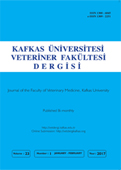
This journal is licensed under a Creative Commons Attribution-NonCommercial 4.0 International License
Kafkas Üniversitesi Veteriner Fakültesi Dergisi
2018 , Vol 24 , Issue 1
Geriatric Cardiology in Dogs - Part 1: Classification and Treatment of Heart Failure in Geriatrics
1Department of Internal Medicine, Faculty of Veterinary Medicine, Near East University, Near East Boulevard, 99138, Nicosia - NORTHERN CYPRUS
DOI :
10.9775/kvfd.2017.18580
The purpose of this article is to give current current information on the effect of aging on heart, clasification of heart failure (HF) in geriatric
dogs and therapeutic advances and challenges. The aging process results in a host of physiological and biological changes that lead to
progressive HF. Nearly any cardiovascular disease (CVD) can lead to HF. HF in geriatric dogs is broadly classified into: Diastolic heart failure
is defined as HF with preserved ejection fraction (HF/PEF), systolic heart failure is also known as HF with low ejection fraction (HF/low-
EF). Importantly, HF/PEF accounts for approximately 50% of all HF patients and its prevalence is higher in the elderly. In humans, mortality
and morbidity benefits for HF/low-EF have been reported with angiotensin-converting enzyme inhibitors (ACE-Is) or angiotensin receptor
blockers (ARBs), β-blockers and aldosterone antagonists, and the hydralazine–nitrate combination in patients intolerant to ACE inhibitors or
nitrates. Therapies for symptom control and morbidity benefit include diuretics and digoxin. The most common and suggested therapy for
dogs with HF by ACVIM panelists is furosemide, ACE-I and pimobendan. Pharmacological therapy is limited for HF/PEF as the results of small
trials have been inconclusive. To date, clinical trials in HF/PEF patients have not shown mortality benefit so that management is focused on
symptom relief and treatment of the underlying cause.
Keywords :
Geriatric Cardiology, Classification, Treatment, Heart Failure, Dog











